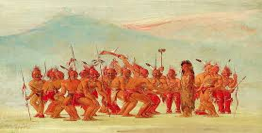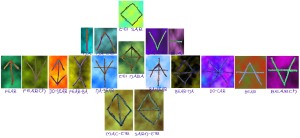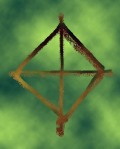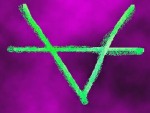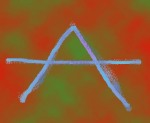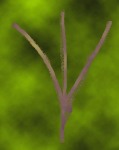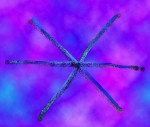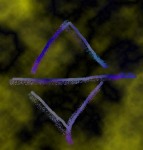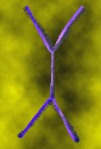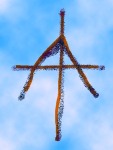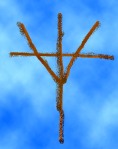When we consider the concept of gender we get lost in the modern dictates of conventional classification that have been handed down from Judaic and Christian ideologies. And I will suggest this was a means of maintaining control from a male dominated religious perspective, which in probability derives from a personalisation of the deity as a male companion, male friend, male lover, male warrior or as a male stereotype to model or refer a frail sexuality on. And here we have the first distraction from the concept of gender that of sexuality.
When we speak of gender we speak of a state of being, whereas sexuality is a manifestation or behaviour of expression that may or may not emanate from that specific gender.
It is suggested that in some ancient primal soup, there was one gender, much like there is amongst many primitive life forms. The theory is that the division of gender into two halves was to create greater diversity for evolution; one gender produces the same result in reproduction, whereas two genders are more like a lottery and producing either or both genders halves to match current environment dictates. One might consider that in this lottery if there were more than two genders, the resulting progeny would be infinitesimally varied and would produce greater reflection and response to he need of the environment.
For the Ancestral Elders of Sagh’ic they saw almost exactly this.
They saw that the Spirit of all was one gender, Tei Sar, complete, whole, unmoving, the hub as it were of creation
Tei Sar needs to create diversity so that the manifest world has the best chance of surviving and in this descends to earth as multiple genders.
For us the need for multiple genders is one of survival, one of friction that the Great Wheel can continue to turn so that we assume we can at some point return to that status quo point of one gender. But for now given we have left that harmonious oneness, we require that friction; and friction is produced and maintained by diversity.
Our Ancestors did not see gender as multiple individualities rather as parts of a greater reality.
As humans we have created internal friction to maintain judgement so we can avoid the journey of challenging the three great fears; Abandonment, loneliness and being different, by this we have created duality rather than a flowing of integral parts.
A pendulum goes to the left and then it goes to the right.
We do not say, “here is left pendulum and here is right pendulum”
We see the movement of the pendulum. Sadly we do not apply that to the world around us, we divide into this and that and make no awareness that both are connected in a greater thing.
“This is good, that is bad!”
“This is alive, this is dead!”
“This is male, this is female!”
Our minds require separation and duality to avoid touching our truth and the truth we avoid most is that this pendulum at the very centre of its arc stops, it is neither moving to the left or the right, it is neither one thing or the other, it is well nothing and in that same awareness it is everything. We say ‘Tei Sarna’ “The moment is everything and everything is in the moment – which is nothing”
BUT…
In the great wisdom of the Ancient Ones, we need the movement of the pendulum to become aware of the liminal point of no movement; movement is our journey and we require friction to move.
The gift of diverse gender is that friction, that ability to bring about change, to bring about reaction so there can be creation.
Fewer genders, less friction, less movement, less creation.
Gender is as currents within a rivers flow and depending on the environment that river is in at any moment differing currents occur and take precedence or reduce so that the river flows relative to the needs of the river bed etc.
No one current is identified as being separate each plays its part in moving the river at this moment of its flow.
Gender now becomes the spirit of the river, its soul, its song, the means by which we see ‘river’ and we see what the river is doing, which is flowing and bringing water to the land and indeed changing the land by its friction until it becomes one with the sea.
It we set down the human need to diversify and apply dualistic notion, we might see that which we call gender is in truth the weaving of currents that move our tribe onwards to its eventual goal. Without these currents the river of our race would become nothing more than a stagnant puddle.
Humans avoid change, they will do all in their power to maintain what they know as assumedly safe, which we are now going to refer to as stagnant.
When we have stagnation we open ourselves to external control, dogmatic rules, isolationatory practice; let us look at our world today focussed on preserving the known to the point of discrimination, ethnicity, holy wars, religious intolerance and ignorance of the environment, not to mention overpopulation, maintenance of life when there should be none; by avoiding the flow of the spirit in its diverse oneness, we have created a sepsis of extinction for ourselves and for the environment around us.
Our Ancestors saw this collaboration of the flows with the spirit, with the flows of the elemental world come together in each human as divine given teacher (and friction) to facilitate and maintain the journey of the tribe; they did not identify a gender per se, rather the gift that would bring value, movement and new wisdom to the tribe. That spirit sent gift created from the coming together in spirit intimacy and ecstasy with the same passion that rose up from the earth, came because the soul of the had called for this particular need.
Each child was allowed to freely express their abilities regardless of physical gender until at a given point, probably at the onset of puberty, that child still of undefined gender was sent with the hunters by the gatherers so that they could hunt their song. The hunters would return with that child who would declare their gifts and role to the tribe. Now and only now the female elders would ascribe the sacred duty of tribal gender, which was related to the part this child had chosen in the weaving together of their tribe.
There would be celebratory and initiatory ceremonies to name the child and honour it for the gift of its weave, which it had brought to the community.
Because there was no fear of abandonment, being alone or being different, there was no judgment; this was celebration for the intervention of the spirits to the tribe who needed such a blessing in order to survive.
As with all tradition there were the archetypes of The Female and The Male and at times these archetypes were applied to the spirits more often than not to support or enact an essence or quality of behaviour.
The Lightning is applied as male to ensure all knew of his strength, his fortitude, his purpose, his loudness, in fact one might conclude that the application of archetype male and female in these ancient times were somewhat ‘tongue in cheek’ sacred jokes.
The archetypes were pivotal if not liminal points in a circular movement, rather than actual states of being.
The definition of Seanamhair Cuan is primarily that of female ocean, and yet at the point in the ancient story she calls for the companion, the companion who is male come from within her, so even here there is the notion of the genderless in its self awareness of the need for genesis either divides or creates gender to promote that explosive friction we come to know as creation.
We have the story of the first woman Bearch woven from the female and, as the stories say, only gives birth to female children. The stories tell of the male spirit coming out from the elemental union with the stars, the union of life and death, fire and water to create the friction that produces diverse gendered children.
Gender is a deliberation of the spirit to instigate creation, which is an explosive change in any stasis.
Our Ancestors imagined the cosmos as a woven fabric, each thread being uniquely needed to relate to the other threads in order to maintain the integrity of the weave and the cloth; every thread was honoured in its role to do this, and the ultimate goal was the piece of cloth, which at some point made up of some many threads (genders) became genderless.
It is the product, the final point, which is the goal; each thread brings us to that.
I see a footprint in the sand, I know this is the safe way and place to tread I am in deep gratitude an love for the one who because of who they were placed that foot print here; how can I judge the one who walked before me?
The weave of the genders for the Sagh’ic was and is their comfort in the knowledge that the spirits walked with them, guided them and held them safe to the point when all individuality ceased. The weave of all these threads was their strength and reliance that they would reach their goal. It is sadness that in today’s world we use the same to excuse our insecurity and our behaviours, which lose our integrity with the other.
We have come in modern times to speak of third gender, which most of the times means anything other than male or female but neither and is often referred to as ‘a state of mind’. Our ancestors did not leave this to ‘states of mind’ that held or was supported by consensus or indeed the three fears. For them Gender was collaborative state of soul. The same might be said for any gender when the approach is confused with sexuality,
In Confessions of a Sociopath: A Life Spent Hiding in Plain Sight, M.E Thomas says, “When you grow up as a girl, it is like there are faint chalk lines traced approximately three inches around your entire body at all times, drawn by society and often religion and family and particularly other women, who somehow feel invested in how you behave, as if your actions reflect directly on all womanhood.”
Sexual orientation was not a concept truly known to them, what they saw maybe a male or a female body, their truth was the footprint not the foot that made it. As for sexuality, this for them if they recognised it, was the social or physical enactment of the intimacy between the spirit and elemental weaves, which manifested as the relational interactions with all the other weaves of the community which that individual was part of. Orientation and sexuality were more seen as the visible theatre of the internal soul, sometimes celebrated and sometimes ignored depending on the timing of events and life.
Tamora Pierce in her book, ‘The woman who rides liked a man’ said…“You ride as a man, fight as a man, and you think as a man-“I think as a human being,” she retorted hotly. “Men don’t think any differently from women- they just make more noise about being able to.”
I think this is a good descriptor about sexuality, but nothing to do with the truth about the soul of the woman being spoken of.
The presence of the twinned soul/body was the sacred, orientation and sexuality the sacrament.
It is a sad reflection of the current stagnation that in modern times we have sexism, positive & negative, as means of control and power. One might be forgiven for assuming by this it is taken that sexism is a control of one sex by or towards another. The truth is a little more alarming. The control is of the three great fears resulting in judgement, which in turn is never about the other rather about the self; one might say feminism has become an oppression of the feminine in itself; the ‘new man’ concept is oppressive control of the masculine by men. This is because we have lost our spiritual understanding of gender as a spiritual state and resorted to orientation and sexuality to control our fears of being abandoned, being alone and being different out of which we bring judgement to others for seemingly creating those fears, and as such we have judged ourselves.
God said to the man, “Why are you hiding?”
The man said, “Because we were naked and I was afraid.”
The tester has made man afraid to be himself, so unable to be honest he judges himself, which he projects outwards and judges God.
It is that very fear that keeps us in the stagnation of self honesty and self acceptance as spiritual genders. This results in a continuous struggle to maintain the addiction to modern concepts and projections. For our ancestors without resource to pharmacology, surgery, activist groups, life was celebrated in the weave of current incarnation as a self-chosen means to serve the tribe.
Gender today is about power and this power is derived from fear, which creates that stagnating judgement.
At some level it may seem impossible to ‘go back’ to such a harmonious life of spiritual integration, the alternative is to struggle be or be come something that is not our soul. And maybe pharmacology, surgery, activist groups is the manifestation of necessary struggle in today’s dispirited society where we celebrate threads rather than cloth and avoid weaving!
The ancestors understood the weaving as collaborative ‘teamwork’ in order for survival. They made no judgments about the weaves nor did they have any need to excuse the ideology of weaves, this is a contemporary control issue.
Within the specifics of the Sagh’ic Tradition eleven main genders were celebrated, each was a point in a flowing of spirit and elementals, with some focus on the physical manifestation and/or inherent ancestral skills and wisdom. They did appreciate physical orientation, yet only as a part of the weave song.
These genders were seen as integral threads in a tribal weave, with each thread supporting, contributing and guiding the integrity of the tapestry of the tribe in an interdependent collaboration. This meant that none survived alone without the weaving into and out of the definition of each other’s diversity.
Even though in the tribal setting of history it seems that specific ‘roles’ were ascribed to specific genders it might be more appropriate to say that these weaves held the ‘medicine’ or the mysteries of that magic of those roles. We as a community find an awareness of empowerment of the responsibilities inherent in the magic of all of women’s and men’s soul. It may be clearer not to look at the weaves as static or complete gender definitions, rather as points of focus in the fabric of the tapestry, or a turning of direction in a flowing river, of the journeys of Tei-Sar through the waters and threads of Na and Ba; each new turning of moment of focus brought a new challenge into the flowing and weaving. It seems always to have been so that the miraculous diversity of the gender flow brought new thought and direction through challenge and change.
These weaves as they were in many ancient traditions and cultures need to be understood as gender was understood in the past; they have to be viewed from the past, looking forward. In these contemporary times there needs to be a moving out of the “now, looking back” frame of mind in order to understand gender differently. This is primarily because gender is such a deep assumption for contemporary people. The assumption is, biology = gender = role =sexuality = orientation, and then, that these things somehow define a type of spirit, as in good or bad. Yet, across the globe indigenous people didn’t make the assumption, even in cultures with strong community “gender roles”, like tending the hearth, making pots, or creating ritual, they still didn’t make the assumption.
“Gender, our maleness and femaleness, is determined by biological, social, experiential, and sexual factors. In shamanic cultures it is believed to also be determined by spiritual factors. Gender, particularly gender variance, is an aspect of shamanism. Traditionally shamans are of female, male, or a transformed gender. Gender is apparently fluid and flexible. Gender is not an inborn trait. Biological sex, social roles, and sexual orientation are not linked biologically, but are influenced by each other. Gender identity is part of a range of options for human expression. Shamanic cultures look at the nature of these possible options as the unique expressions of the human spirit.” Christina Pratt Encyclopaedia of Shamanism
Na-Tei and Ba-Tei are not just male and female, but they are yin and yang and as such are found together within each person. So we all have all of the designations within us. The constraints applied are those of the manifest vehicles Na and Ba, which society has come to define as man and woman. We may live a whole life presenting one of the 11 as our authentic expression of our self or we may gradually move through several as we transform through life, each an authentic expression of self. It is important that people don’t treat the 11 designations as we use “gay” or “straight” or “bi” or etc. People were not asked to choose and identify with one of the 11 because everyone contained everything, and at this point of the flowing they came to the surface of the river of life or at this point of the weaving they were this combination of coloured threads.
In the Weave of the Tradition there is no man or woman definition, merely containers for the flowing river or the looms for the tapestry
NOTE: the V is the symbol for the sacred path of life transformation of a womb-bearer, regardless of other distinctions. The life giving void is within, the path is to draw from it and give to the people. The upside down V is the symbol for the sacred path of life transformation of those born without a womb, regardless of other distinctions. Their path is to find the life giving void.
The cultures that recognized more than two genders and held respected roles for gender variant individuals often held a pantheistic view of the spirit world. These people worshipped and array of archetypes, including Great Mother Goddess, Amazonian female warriors, male consorts of goddesses, and deities of both sexes who embodied metamorphosis, gender variance, or same-sex eroticism. With these images imbedded in the spiritual awareness of the people, the gender variant individuals were perceived of as sacred people, reflecting the unknown, the Great Mystery, and the chaotic variety of the spirit realms.
Any individual may or may not express the gender identity implied by their biological sex, or morphology. They may vary in gender identification, style of dress, economic role in community, or sexual orientation. Traditional shamanic cultures believed that the traits expressing gender and gender variance were bestowed by divine powers. Therefore, these qualities were essential to the individual, not a culturally constructed behaviour. Furthermore they believed that the unique perspective and wisdom gender variant individuals brought where essential to the health of the community. Conner, R.P. Blossom of Bone.
As we reflect on the weave/gender ciphers it will be seen that all the female genders, including Tei-NaBa and Ba-Sear are connected by the horizontal line of the female line Ba.
This reinforces that the female is unified in whatever definition to Art-s-Wath the primal forest. Whereas all the ‘Fear’ ciphers of the male appear to stand alone, this relates in part to the story of Fear being afraid to be one with the Forest.
In all of this, the weave of threads followed a specific pattern to ensure the tribal integrity and progression. There were general taboos, not as prohibitive rules, rather as identifiers of sacred boundaries; in one sense to preserve the unique sacred. Women based on orientation did not take life given that men did not bring life. Female spirit was inward and contained, gathered and held whereas male spirit was outward and directive, explosive and destructive. Women instructed and called whereas men acted and replied.
In a black and white sense women would send men to hunt, men would return with the hunt in order that the women could preserve the wellbeing of the tribe.
Women were the hub of the tribe and men the rim, and here we are speaking still in reference to outward orientation.
All plant medicine including poisons were solidly female as these were from the forest and earth
Animal ‘husbandry’ when it was local and connected to the ‘hearth’ reindeer milking etc, which would have included all connected to the earth, pottery, making utensils, collecting natural objects, body adornment and the making of images. Women would hold sacred the brewing of mead and ales, and the keeping of bees. Women were also the keepers of records and diviners in their role as preservers of the tribal integrity
As women were bringers of life, it was their sacred duties to prepare the dead for funeral rites
Men on the other hand were the hunters and destructors and despite their association with death were also the ones who danced for initiations, which included birth. They were the tenders and carriers of the dead and used fire to forge specifically weapons and items that would be used in the taking of life or destruction.
The specifics in these archetypal roles were focussed and detailed by the in ancient tribal lore and tradition by the gender weaves. In understanding the weaves there is an obvious collaborative support by the twinning in each weave; the focus was so that the tribe did not go wanting.
It is of note that often it is the women who sing and the men who dance. This reflects the first stories when the female spirit sings out to call the male spirit to dance in; Mora-oa-Creon is considered to be female.
Dancing in this way was specific to the event, ritual, ceremony and/or celebration. It does seem that in general terms men and women danced and sang, albeit it on some occasions they did this separately or in response or refrain to each other. The point was that singing and dancing like male and female genders was a unification of purpose; without the collaborative unification, the purpose was never achieved.
Each pivotal point in the gender weave/flow was named or more correctly, given a spoken prayer or blessing, which modern concepts identify as ‘name’, which once again fixes a spiritual response that is unfixable. Each blessing indicates an interactive connection with the whole.
The assumed specifics of these weaves appear in some way as the following;
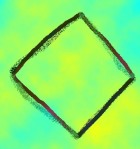 Tei-Sir is the cosmological cycle of invitation, reception, creation, destruction and rebirth through invitation, reception, creation destruction and on into infinity.
Tei-Sir is the cosmological cycle of invitation, reception, creation, destruction and rebirth through invitation, reception, creation destruction and on into infinity.
Tei-Sir; “Everything in the moment is the moment of everything,” is not a definition of deity, rather an animation and rippling of that cycle.
Tei-Sir is that moment in the story of the first man & woman, Fear & Bearch, when they unite and create San Cràdh (Perfect/Sacred Love) in their union; the epitome of the perfection of the female soul and the male soul in that eternal turning.
Before the burden of the shadows of the dream of life, Tei-Sir is the spirits song in that perfect balance and harmony, each woven into one essence. This essence in the stories of the ancestral Elders is made up of
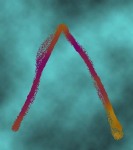

Na-Tei, the male half of the song (or soul) and Ba-Tei, the female half of the song (or soul).
 Na – the male physical form
Na – the male physical form
Ba – the female physical form
This Spirit Song (soul) comes to the Earth through Ygriddia, the Song of the Great Tree and is received by the Elementals who in turn create a vessel for that song. This vessel, body, life, destiny, reflects the balance of the two half souls, male and female, within Tei-Sir. The song of Tei-Sir will be heard in diverse melodies to reflect the needs and flowing of the community.
Within the stories of the Ancestral Elders are identified eleven vessels, i.e. genders.
These genders were seen as integral threads in a tribal weave, with each thread supporting, contributing and guiding the integrity of the tapestry of the tribe in an interdependent collaboration. This meant that none survived alone without the weaving into and out of the definition of each other’s diversity.
These eleven Genders or Weaves were identified as:
As Te-Sir is the perfect Twin Soul, so Tei-NaBa (Na being the physical form of male and Ba being the physical form of female) is the rare being of the harmony of Te-Sir manifested in physical form, being both male & female in both soul & body (Hermaphrodite). This being was revered amongst the others as a deified being that came and remained present with the community for a specific purpose and that that the spirits had caused its birth as an oracle or message bearer. It may have been that in these ancient times the Tei-NaBa did live for a great length of time, being so close to the divide between the spirits and the mundane.
The Hearth Keeper
Sometimes referred to as the Hearth, was the container and matriarchal leader of the tribe or group. This female leadership was a direct reference to the Female Triune the ancestors revered, that of Sean, Máthair-cuan, the Great Ocean, Màthair Tei, the earth and Art-s-Wath the Forest, which had reference to eternal wisdom and maternal governance. She was both the gatherer and the gathering of the family and the directorix of tribal initiative. It was her calling that brought the ‘children’ from the shadow places.
The Hunter
Fear was the Stone Caster, the one who sought the means to survive and established the anchor points of the nomadic encampments of the tribe. He was the discerner; the one who heard the information then selected the right path forward. He was the seeker, the provider and the paternal leader of the tribe or group. In reference to the stories of the first man, he was seen in an explorer and testing role and whereas Bearch gathered, Fear directs, guides and sends out the ‘children’.
It is important to state that as a basic taboo amongst the community and all the weaves (genders), woman who brought and gave life never killed or ended any life; only men were allowed to kill. It seems that this ‘rule’ was waived when the tribe or community defended itself, which suggested that warrior was not defined by any specific gender and men & women fought along side each other as equals.
The Weaves of Bearch & Fear are seen more as archetypal definitions and were within the tribal setting were defined as pillars (as in supporting) of the tribal community and may have truly held such leadership roles as defined by their gender characteristics. It is presumed that with the concept of Tei-Sir weaves (genders) worked in paired functions that ‘fed’ into the needs of the tribes through the elements or notions or individuals recognised as Bearch & Fear in the concept of Tei-Sir.
Each weave/gender was a participle of the overall tapestry, which, in turn was the perfect manifestation of the spiritual Tei-Sir.
In one sense no weave was perfect in its separateness, although each thread was seen and appreciated as a beauty in its purpose, as only the coming together of the weaves/genders created the perfect moment of song that mirrored or was Tei-Sir. We should be reminded that Tei-Sir is defined as the “Moment of Love.”
Within the weaves, roles of any pair of and in all genders, was a complementation of each other’s opportunities and responsibilities within the ancient tribal setting. It is the service of each within the weaves, which is the suggestion of ‘pair’ rather than a physical collaboration.
The Tentmakers
Female Body with Male Soul & Male Body with Female Soul
The presumed and ascribed service of this weave pair into the cycle of tribal Tei-Sir was the husbandry of animals and plants, which included the making of fabrics from fur and plant fibres. The weave nay have included tanning hides, cloth making, bee keeping, brewing and medicines.
The Makers of Magick
Female Body, twin souled with female soul dominant & Male Body, twin souled with male soul dominant
The presumed and ascribed service of this weave pair into the cycle of tribal Tei-Sir was that of rites of passage and divining. This included working with and through the rites of birth & death, teaching and matchmaking!
The Dreamweavers
Male Body, twin souled with female soul dominant & Female Body, twin souled with male soul dominant
The presumed and ascribed service of this weave pair into the cycle of tribal Tei-Sir was that of the Seanachais, the storyteller and Smything. They were the carvers and adornment makers. They were the makers of music & song.
The Watchers
Female Soul in Male body & Male Soul in Female body
The presumed and ascribed service of this weave pair into the cycle of tribal Tei-Sir was seen as those who lived on the edge of the shadows. As such they were able to see and be unbiased by any side and were often ascribed the duties of judge, mediator and challengers (fools). They were also the keepers of poisons and destruction.
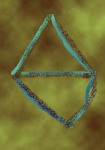
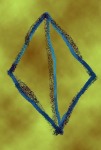 Alongside these 5 male & 5 female weaves and that of Tei-NaBa, were the two additional weave/gender definitions of Mac-Tír and Sarn-Tir.
Alongside these 5 male & 5 female weaves and that of Tei-NaBa, were the two additional weave/gender definitions of Mac-Tír and Sarn-Tir.
These were the weaves/genders of choice and destiny and were the surrender and sacrifice of the Ceann-Iuíl
These were considered (and expected to be) gender variant. This was the prescription that the ceremony, ritual or event determined the gender and in some cases the orientation/sexuality of the Ceann-Iuíl within that ceremony, ritual or event. This was achieved historically by apprenticing through all 5 male and 5 female gender definitions in order to achieve an animistic sense of the presence of Tei-NaBa. In some historic cases Ceann-Iuíl in line with many other cultural traditions was of transformed gender, which was a process not entirely a spiritual metaphor but a physical re-assigning of the physical manifestation of gender.

